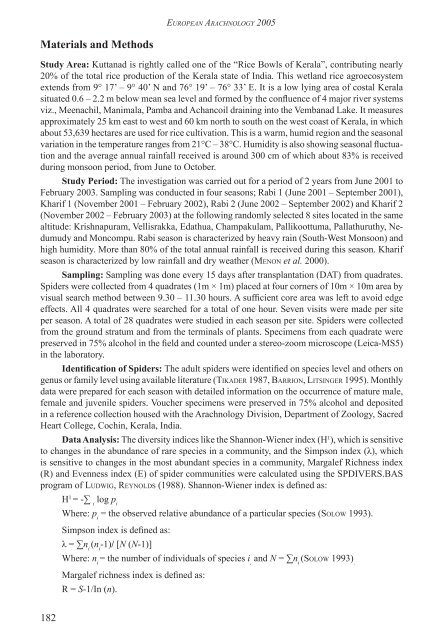Sudhikumar AV, Mathew JM, Sunish E & Sebastian PA - European ...
Sudhikumar AV, Mathew JM, Sunish E & Sebastian PA - European ...
Sudhikumar AV, Mathew JM, Sunish E & Sebastian PA - European ...
You also want an ePaper? Increase the reach of your titles
YUMPU automatically turns print PDFs into web optimized ePapers that Google loves.
Materials and Methods<br />
182<br />
EuropEan arachnology 2005<br />
Study Area: Kuttanad is rightly called one of the “Rice Bowls of Kerala”, contributing nearly<br />
20% of the total rice production of the Kerala state of India. This wetland rice agroecosystem<br />
extends from 9° 17’ – 9° 40’ N and 76° 19’ – 76° 33’ E. It is a low lying area of costal Kerala<br />
situated 0.6 – 2.2 m below mean sea level and formed by the confluence of 4 major river systems<br />
viz., Meenachil, Manimala, Pamba and Achancoil draining into the Vembanad Lake. It measures<br />
approximately 25 km east to west and 60 km north to south on the west coast of Kerala, in which<br />
about 53,639 hectares are used for rice cultivation. This is a warm, humid region and the seasonal<br />
variation in the temperature ranges from 21°C – 38°C. Humidity is also showing seasonal fluctuation<br />
and the average annual rainfall received is around 300 cm of which about 83% is received<br />
during monsoon period, from June to October.<br />
Study Period: The investigation was carried out for a period of 2 years from June 2001 to<br />
February 2003. Sampling was conducted in four seasons; Rabi 1 (June 2001 – September 2001),<br />
Kharif 1 (November 2001 – February 2002), Rabi 2 (June 2002 – September 2002) and Kharif 2<br />
(November 2002 – February 2003) at the following randomly selected 8 sites located in the same<br />
altitude: Krishnapuram, Vellisrakka, Edathua, Champakulam, Pallikoottuma, Pallathuruthy, Nedumudy<br />
and Moncompu. Rabi season is characterized by heavy rain (South-West Monsoon) and<br />
high humidity. More than 80% of the total annual rainfall is received during this season. Kharif<br />
season is characterized by low rainfall and dry weather (mEnon et al. 2000).<br />
Sampling: Sampling was done every 15 days after transplantation (DAT) from quadrates.<br />
Spiders were collected from 4 quadrates (1m × 1m) placed at four corners of 10m × 10m area by<br />
visual search method between 9.30 – 11.30 hours. A sufficient core area was left to avoid edge<br />
effects. All 4 quadrates were searched for a total of one hour. Seven visits were made per site<br />
per season. A total of 28 quadrates were studied in each season per site. Spiders were collected<br />
from the ground stratum and from the terminals of plants. Specimens from each quadrate were<br />
preserved in 75% alcohol in the field and counted under a stereo-zoom microscope (Leica-MS5)<br />
in the laboratory.<br />
Identification of Spiders: The adult spiders were identified on species level and others on<br />
genus or family level using available literature (tikadEr 1987, Barrion, litsingEr 1995). Monthly<br />
data were prepared for each season with detailed information on the occurrence of mature male,<br />
female and juvenile spiders. Voucher specimens were preserved in 75% alcohol and deposited<br />
in a reference collection housed with the Arachnology Division, Department of Zoology, Sacred<br />
Heart College, Cochin, Kerala, India.<br />
Data Analysis: The diversity indices like the Shannon-Wiener index (H 1 ), which is sensitive<br />
to changes in the abundance of rare species in a community, and the Simpson index (λ), which<br />
is sensitive to changes in the most abundant species in a community, Margalef Richness index<br />
(R) and Evenness index (E) of spider communities were calculated using the SPDIVERS.BAS<br />
program of ludWig, rEynolds (1988). Shannon-Wiener index is defined as:<br />
H 1 = -∑ i log p i<br />
Where: p i = the observed relative abundance of a particular species (soloW 1993).<br />
Simpson index is defined as:<br />
λ = ∑n i (n i -1)/ [N (N-1)]<br />
Where: n i = the number of individuals of species i , and N = ∑n i (soloW 1993) .<br />
Margalef richness index is defined as:<br />
R = S-1/In (n).
















